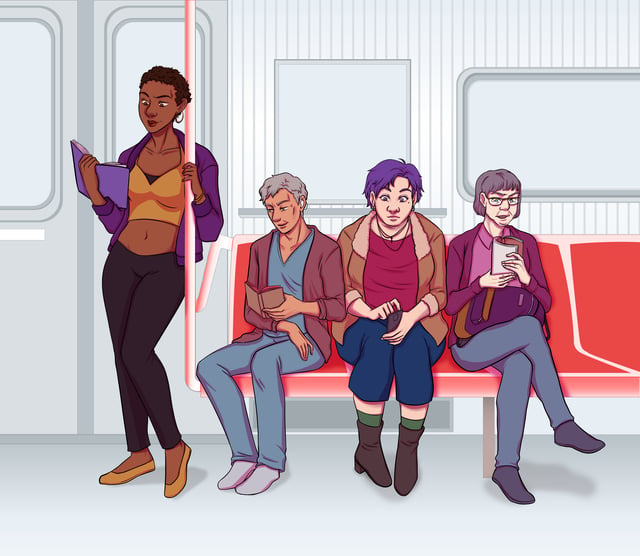Catching up? So far, we've published an intro post, a terminology post, a post on comics creation, a piece on managing your budget, some starter comics, and the Local Comic Shop experience.
Today, we're going to talk about one of the more intimidating and ever-changing aspects of comics: digital funding and distribution.
Part 6: New-ish Channels for Comics Funding and Distribution
The internet is a magical place. You’re here, after all. Isn’t it fun?!
The ‘net has been a huge driver of innovation in publishing, retailing, and comics, and things are constantly changing. Odds are, after this post goes up, something will be out of date. (I’ll update it occasionally.) Still, here’s a quick rundown of some of your digital options for funding, buying, and reading comics. I'll be using Iron Circus Comics, run by C. Spike Trotman, for my examples. Spike is considered the first comics publisher to make Kickstarter really work for her model, and she is the person I think of first when talking about making comics outside the Big Three. (That's Marvel, DC, and Image.)
Webcomics
We've already talked about webcomics quite a bit, so this is just a reminder that there are lots of them to try out and read for free! Many of the things we're going to talk about below are ways to support those webcomic creators and if you're able to, you definitely should.
Kickstarter
First, a warning: Kickstarter is addictive. With an amazing array of projects and a handy recommendation system, Kickstarter is my favorite place to discover new projects to support. It can also get expensive really quick. (I have a post in the works on how to decide if you should back a project on Kickstarter, hopefully I'll share it soon.)
Here's how it works:
Creators of art, products, music, etc. set up a "campaign" for a set amount of time, usually 30-60 days. Then they spread the word and people "back" the project. Backers choose from an array of options set by the creator. For comics, it's usually everything from a PDF copy of the finished work to a hardcover book with signed prints. You can expect to pay anywhere from $5-50 depending on what format and extras you want. Artists will often add commission tiers for their super-fans. Take a look at this 18+ project from Iron Circus. It's a great example of how creators can tell you about their projects and offer an array of purchase options.
Unlike some other crowd-funding platforms, Kickstarter is all or nothing, which means that if a project doesn't meet its funding goal, it fails and no money is collected. This vastly increases the likelihood of you actually getting what you've paid for. Each creator is also required to fill out a section on risks, telling you what they see as possible obstacles to timely completion and delivery.
At the Kickstarter Comics & Illustration page, you'll see some highlighted projects, but I prefer to follow creators. Following creators on Kickstarter means you'll get an email when they launch a new project or back a project. Since the creators I like also like similar things, I've found quite a few artists and comics this way.
Patreon and Drip
Drip is Kickstarter’s new answer to Patreon. As I’m writing this, it’s invite-only for creators, so they’ll tell you if they have one. You can also browse the current roster here. Spike has one! You can read about that here.
Okay, now let's talk about Patreon. Patreon is an online funding platform that's ongoing rather than one time, like Kickstarter. You sign up to support (become a patron of) a creator for $1 or more each month. A lot of webcomic creators have a Patreon account.
What They Get:
- Monthly support, rather than relying on a traditional publishing model that requires them to have made an entire book before getting any compensation
- Feedback directly from their audience on their work, through polls, etc.
What You Get:
- More of the content you love, in the form of patron-only sketches and pin-ups, process videos, and more. Some creators are better at this than others.
- Frequently, creators put up several days or weeks of comics before they go up on the main webcomic site for free. This gives you early access to the work.
- Sometimes... you get entire comics via Patreon that aren't available elsewhere. Gina Biggs did this recently with a NSFW cut scene from Love Not Found.
ComiXology (Unlimited)
First, a confession: I buy some of my comics on ComiXology. I have reasons!
I like sales. I also like their reading app, since it lets you zoom in and read panel by panel. This is really a boon for readers with certain vision impairments.
ComiXology also has a new “Submit” feature, which allows indie creators to put their work up for sale. Novae is a personal favorite of mine. (Love in Panels doesn’t get commission from anything at ComiXology, so this is all my completely honest opinion.)
So, ComiXology is an Amazon company and I don’t think we should feed the Beast if we can avoid it. I am a walking self-contradiction. Here’s my own personal compromise: I do not subscribe to anything via their service, including their Unlimited program. I also make sure to support my must-read series at my LCS rather than via the ‘Zon. Look at your budget and your reading habits, then find your own balance.
Their Unlimited program is a lot like Kindle Unlimited. You get access to a library of “10,000 comics, graphic novels, and manga” for $5.99/month after a 30 day free trial. Many of the big faves are in there, as well as a bunch of lesser known stuff.
Gumroad and More
Lots of comic creators sell digital copies of their work in PDF form via Gumroad. As a reader, I like that I can directly download my comics or add them to my Gumroad account and access them when I'm ready to read. Comics take up a huge amount of space on my tablet, so I like knowing that if I archive the work, it'll be there for me later. One of my favorite indie finds is The Weave, by Rennie Kingsley. I wanted to support her work and Patreon was being shady (this seems to be over now), so she made PDFs of the first few chapters and tossed them up here.
Tapas, a webcomic platform, has a tipping option. You buy a block of credits and then tip creators when you feel like it.
Ko-Fi is another tipping mechanism used by everyone from Twitter influencers to YouTubers to comic artists. The idea is that you are buying the creator a coffee, with a system that encourages you to chip in $2-3 one time.
Comics Collectives
I've talked about HiveWorks before, but I really love the concept and the execution there. A group of creators get together and join forces to promote their work. Also check out InkDrop Cafe and Sparkler Monthly (not a collective, but a digital magazine with a big archive of multiple creators).
This concludes my giant info-dump. AKA, here is everything I know about comics.
Next I'm just going to have fun and tell you all about the NSFW comics I love. Then I'll completely switch gears and offer some suggestions for kids!
Coming Up...
Part 7: Dirty Comics
A guide to comics for the 18+ crowd, with an emphasis on sex-positive, LGBTQ+ and female-friendly content.
Part 8: Comics for Kids
AKA, what to buy your niece/nephew/child/local library to get kids reading.
If you have any questions, please feel free to send them to suzanne@loveinpanels.com. I’ll gather questions as we go and answer them at the end if they aren’t covered in a post. Happy reading!

